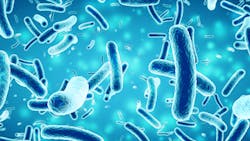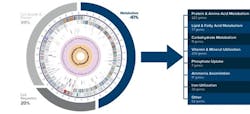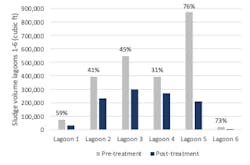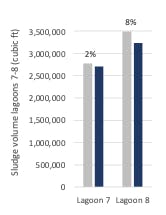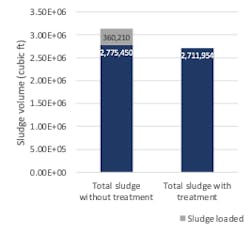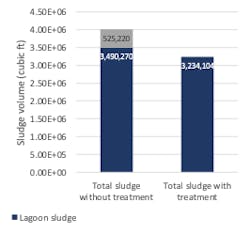Bacillus-Based Bioaugmentation Reduces Sludge In Wastewater Lagoons
More than 50% of industrial wastewater treatment facilities in the U.S. employ lagoons in their treatment process (4). Sludge is an integral part of a lagoon system, but excess amounts can negatively impact performance. Accumulation of sludge alters the holding capacity of the lagoon and topography of the bottom (5).
These changes can result in decreased hydraulic retention time and subsequently reduce treatment efficacy. Sludge management in wastewater typically amounts to 40 to 60% of total plant costs, but charges relating to sludge disposal, such as transportation and landfill costs, have been trending upward, and regulations for land application are becoming stricter (7).
One solution to help mitigate these rising disposal costs is the implementation of a biological treatment. Organic sludge components can be effectively digested with a biological treatment, reducing the frequency and cost of mechanical removal events, and making bioaugmentation an attractive sludge management option.
What is Bioaugmentation?
Bioaugmentation aims to increase sludge digestion by enhancing the biology that naturally exists in the environment through the addition of bacterial species and/or nutrients that support microbial growth.
In wastewater, the goal of employing bioaugmentation in the form of a bacterial species, such as Bacillus, is to augment the native population and attain a community that more effectively digests sludge (2). Sludge composition varies greatly based on the influent sources, but studies have found that municipal sludge is mostly organic with carbohydrates, proteins, and lipids accounting for over 50% of this organic portion (1, 8).
The addition of a bacterial species like Bacillus helps to enhance the natural sludge digestion process by breaking down complex organic matter in the sludge to create intermediate metabolites that they and other bacteria in the wastewater environment can consume. Biodegradation of sludge is a multi-step process involving the whole bacterial community with a variety of organisms that possess different digestive abilities. As a result of the bacterial activity in the system, the components of sludge are either incorporated into new microbial biomass or are ultimately converted to water and carbon dioxide (2, 3).
The amount of carbon dioxide produced due to these processes is minimal especially in comparison to the level produced by alternative mechanical removal methods. Laboratory testing demonstrates an increase in bacterial activity in wastewater treated with Biotifx Bacillus-based products when compared to an untreated sample of the same wastewater (Figure 1). The presence of additional active organisms working to digest more material in their environment, results in measurable differences in lagoon sludge volume over time.
What Are Bacillus Bacteria?
Bacillus bacteria are an ideal candidate for incorporation into wastewater bioaugmentation products. These organisms can enhance the bacterial community as described above and are highly adaptable to an array of environments due to their ability to metabolize a wide variety of substrates.
Bacillus can adjust enzyme production and metabolic processes to take advantage of whatever food source is most readily available. These organisms can even break down some of the more difficult to degrade complex carbon sources such as hydrocarbons or residual dyes from production processes that may otherwise persist undigested through wastewater treatment (10). Analysis of the whole genome sequences of Biotifx Bacillus strains demonstrated that they are equipped to metabolize a wide variety of substrates that could be encountered in a sludge environment (Figure 2). Each Bacillus strain is unique, so a product designed to incorporate several complimentary strains is an effective approach to wastewater sludge treatment (2).
Sludge accumulation is an important factor to consider in the health and efficacy of wastewater treatment lagoons. Bioaugmentation with Bacillus-based products is a reliable solution to reduce the need for more mechanical sludge removal methods. In this study, we have analyzed data in 11 diverse lagoon systems treated with Biotifx and found that sludge was reduced by an average of 56% (SD = 33%) within the first year of treatment.
Methods
The goal of this study was to analyze sludge data from a range of different lagoons treated with Biotifx products. The 11 lagoon systems studied were located across 8 different U.S. states (n=9) and two additional countries (n=2) and spanned a wide range of industries and lagoon sizes (Table 1).
Before beginning treatment, each lagoon was surveyed to create an appropriate treatment plan. Basic lagoon statistics such as surface area, volume, and daily flow, along with water and sludge samples were collected. Sludge measurements were collected using a sludge judge at multiple locations throughout the lagoon proportional to lagoon size. These measurements were then used to calculate the average sludge depth of the lagoon. For Lagoon 7 and Lagoon 8 sludge loading was estimated using the facilities’ daily loading data. In cases where sludge was so built up that it prevented proper sampling, the percent of the surface area with sludge up to or above the water surface of the lagoon was calculated before and after treatment.
The length of treatment varied by location from 2 months to 1 year. Product was applied daily, weekly, or monthly depending on several factors including size of the system and daily flow rates (hydraulic retention time), severity of the sludge accumulation, and ease of application at the site.
Significance between pre- and post-treatment measurements was determined by performing a one sample T-test comparing the average percent difference between pre- and post-treatment to the hypothesized mean of 0 with a 95% confidence interval calculated using Minitab 17.
Results
The sludge reduction in each lagoon where sludge volume could be calculated based on sludge judge measurements (n=8) is reported in Figure 3. Lagoons 1 through 6 (Figure 3A) were smaller in size compared to Lagoons 7 and 8 (Figure 3B). Sludge reductions were observed in all eight of these lagoons following treatment with the product.
However, these systems processed more than 2,000,000 gallons of flow per day resulting in large amounts of new sludge entering the lagoon during the treatment period on top of the high levels of sludge already present. Total sludge reduction, accounting for both the sludge volume that was in the lagoon and the amount of sludge loaded during the course of treatment, was actually 14% and 20% for Lagoons 7 and 8 (Figure 4).
Conclusion
Bacillus treatment resulted in sludge reduction in each of the eleven lagoon systems studied. This success was seen in systems of various sizes, across different industries and locations. In total, the products were able to remove more than 2,000,000 cubic feet of sludge in the lagoons studied here. This amount of sludge equated to between 5:1 and 9:1 return on investment as reported by the water treatment facility compared to mechanical removal, sludge hauling, and disposal costs.
Author Information: Jennifer Cray, Megan Duersteler, Andrea Petersen, Dan Romanek, Josiah Menako, Sona Son & Mike King contributed to this article. They can be reached at [email protected].
References
- Parmar, N., Singh, A., & Ward, O. P. (2001). Enzyme treatment to reduce solids and improve settling of sewage sludge. Journal of Industrial Microbiology and Biotechnology, 26(6), 383-386.
- Herrero, M., & Stuckey, D. C. (2015). Bioaugmentation and its application in wastewater treatment: a review. Chemosphere, 140, 119-128
- Low, E. W., & Chase, H. A. (1999). Reducing production of excess biomass during wastewater treatment. Water research, 33(5), 1119-1132.
- Epa, U. (2011). Principles of design and operations of wastewater treatment pond systems for plant operators, engineers, and managers. United States Environmental Protection Agency, Office of Research and Development.
- Nelson, K. L., Cisneros, B. J., Tchobanoglous, G., & Darby, J. L. (2004). Sludge accumulation, characteristics, and pathogen inactivation in four primary waste stabilization ponds in central Mexico. Water research, 38(1), 111-127.
- Logan, N. A. (2009). Bacillus. In Bergey’s manual of systematic bacteriology. Springer.
- Rising cost of solids handling and disposal necessitates a smarter approach. (2020, August 3). Treatment Plant Operator. https://www.tpomag.com/online_exclusives/2020/08/rising-cost-of-sludge-handling-and-disposal-necessitates-a-smarter-approach_sc_001jj
- Dignac, M. F., Ginestet, P., Rybacki, D., Bruchet, A., Urbain, V., & Scribe, P. (2000). Fate of wastewater organic pollution during activated sludge treatment: nature of residual organic matter. Water Research, 34(17), 4185-4194.
- Mlaik, N., Bouzid, J., Hassan, I. B., Woodward, S., Elbahri, L., & Mechichi, T. (2015). Unhairing wastewater treatment by Bacillus pumilus and Bacillus cereus. Desalination and Water Treatment, 54(3), 683-689.
- Hlordzi, V., Kuebutornye, F. K., Afriyie, G., Abarike, E. D., Lu, Y., Chi, S., & Anokyewaa, M. A. (2020). The use of Bacillus species in maintenance of water quality in aquaculture: A review. Aquaculture Reports, 18, 100503.
- Dawkar, V. V., Jadhav, U. U., Jadhav, S. U., & Govindwar, S. P. (2008). Biodegradation of disperse textile dye Brown 3REL by newly isolated Bacillus sp. VUS. Journal of applied microbiology, 105(1), 14-24.
About the Author
Jennifer Cray
Microbiologist III
Jennifer Cray Microbiologist III for Microbial Discovery Group. Cray can be reached at [email protected].
